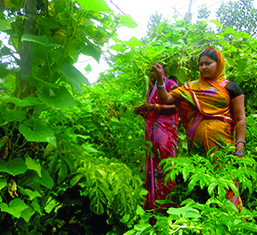To learn more about Digital Green’s AI-powered platform and how it impacts small-scale farmers in India, Ethiopia, Kenya, Nigeria and Brazil, we encourage you to sign up for our newsletter.
Samastipur Sisters – Harbingers of Change

Changes, while they are the quintessence of life, are never easy to accept. Yet, there are some brave enthusiasts who have put their faith in new practices and helped prove the worth of those practices.
I witnessed one such example in a small village called Rajka Rampur of Samastipur district in Bihar where I met two women (sisters-in-law) who were part of a self-help group (SHG). They have been members of JEEViKA since February 2013 and encouraged many others to also join the initiative to improve their livelihood options. Usha and Reena started growing seven to eight vegetables in their kitchen garden measuring 2 katthas (where 1 acre is 22 katthas) in 2012.

In the Zaid cropping season of 2015 (between March to June or the Rabi and Kharif crops) they learned how to make Jeevamrut (an organic fertilizer made of cow dung and urine, jaggery etc) through a Digital Green video.
We grow creepers such as cucumber, pumpkin, parwal, bitter gourd and sponge gourd in the vegetable orchard using the scaffolds prepared from bamboo and plastic wires. We use the main plot for sowing spinach, elephant foot yam, Colocasia plant. Using these techniques, we have managed to grow seven to eight vegetables together in the single plot, shared Usha. Using organic fertilizers will ensure healthy plants and even the produce won’t be hazardous as they were when we were using chemical fertilizers, shared Reena, beaming while explaining.

The cost of chemical fertilizers applied on 2 katthas of land for the same was Rs. 1834 in 2014, where as for the organic fertilizer it was as low as Rs. 774 in 2015.
We have saved around Rs. 1000 as we didn’t purchase and apply urea, potash, DAP, Zinc or Phosphate in the field this time, added Usha Didi. The effort of applying such organic manure has paid off. The household has already generated Rs. 7,500 as revenue by selling the produce and expects more, up to Rs. 16,000 by end of September after household consumption.
I found the method convenient and the low budget required to prepare the organic fertilizer was enough to convince us, explained Usha with confidence. The men in their families have also seen the benefit of using organic fertilizers on their lands where they grow staple crops.
Both now have a common agenda they want to ensure application of Jeevamrut by as many people as possible in their SHG.